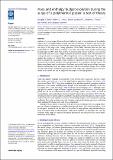Files in this item
Mass and enthalpy budget evolution during the surge of a polythermal glacier : a test of theory
Item metadata
| dc.contributor.author | Benn, Douglas I. | |
| dc.contributor.author | Jones, Robert L. | |
| dc.contributor.author | Luckman, Adrian | |
| dc.contributor.author | Fürst, Johannes J. | |
| dc.contributor.author | Hewitt, Ian | |
| dc.contributor.author | Sommer, Christian | |
| dc.date.accessioned | 2019-09-23T09:30:07Z | |
| dc.date.available | 2019-09-23T09:30:07Z | |
| dc.date.issued | 2019-10 | |
| dc.identifier | 261315084 | |
| dc.identifier | ecff9aa9-ec8e-4dd5-b9e4-93da559c1b34 | |
| dc.identifier | 85071948480 | |
| dc.identifier | 000487667400002 | |
| dc.identifier.citation | Benn , D I , Jones , R L , Luckman , A , Fürst , J J , Hewitt , I & Sommer , C 2019 , ' Mass and enthalpy budget evolution during the surge of a polythermal glacier : a test of theory ' , Journal of Glaciology , vol. 65 , no. 253 , pp. 717-731 . https://doi.org/10.1017/jog.2019.63 | en |
| dc.identifier.issn | 0022-1430 | |
| dc.identifier.other | ORCID: /0000-0002-3604-0886/work/64697405 | |
| dc.identifier.uri | https://hdl.handle.net/10023/18537 | |
| dc.description | Funding for DIB and AL was provided by NE/R018243/1 REBUS (Resolving Enthalpy Budget to Understand Surging), and JJF received funding from the German Research Foundation (DFG) under grant number FU1032/1-1. | en |
| dc.description.abstract | Analysis of a recent surge of Morsnevbreen, Svalbard, is used to test predictions of the enthalpy balance theory of surging. High-resolution time series of velocities, ice thickness and crevasse distribution allow key elements of the enthalpy (internal energy) budget to be quantified for different stages of the surge cycle. During quiescence (1936-1990), velocities were very low, and geothermal heat slowly built-up enthalpy at the bed. Measurable mass transfer and frictional heating began in 1990-2010, then positive frictional heating-velocity feedbacks caused gradual acceleration from 2010 to 2015. Rapid acceleration occurred in summer 2016, when extensive crevassing and positive air temperatures allowed significant surface to bed drainage. The surge front reached the terminus in October 2016, coincident with a drop in velocities. Ice plumes in the fjord are interpreted as discharge of large volumes of supercooled water from the bed. Surge termination was prolonged, however, indicating persistence of an inefficient drainage system. The observations closely match predictions of the theory, particularly build-up of enthalpy from geothermal and frictional heat, and surface meltwater, and the concomitant changes in ice-surface elevation and velocity. Additional characteristics of the surge reflect spatial processes not represented in the model, but can be explained with respect to enthalpy gradients. | |
| dc.format.extent | 15 | |
| dc.format.extent | 1776912 | |
| dc.language.iso | eng | |
| dc.relation.ispartof | Journal of Glaciology | en |
| dc.subject | Arctic glaciology | en |
| dc.subject | Glacier surges | en |
| dc.subject | Ice dynamics | en |
| dc.subject | G Geography (General) | en |
| dc.subject | Earth-Surface Processes | en |
| dc.subject | 3rd-DAS | en |
| dc.subject.lcc | G1 | en |
| dc.title | Mass and enthalpy budget evolution during the surge of a polythermal glacier : a test of theory | en |
| dc.type | Journal article | en |
| dc.contributor.sponsor | NERC | en |
| dc.contributor.institution | University of St Andrews. School of Geography & Sustainable Development | en |
| dc.contributor.institution | University of St Andrews. Bell-Edwards Geographic Data Institute | en |
| dc.identifier.doi | https://doi.org/10.1017/jog.2019.63 | |
| dc.description.status | Peer reviewed | en |
| dc.identifier.grantnumber | NE/R018243/1 | en |
This item appears in the following Collection(s)
Items in the St Andrews Research Repository are protected by copyright, with all rights reserved, unless otherwise indicated.

